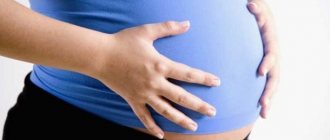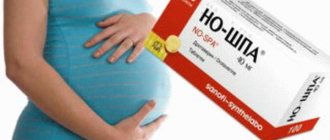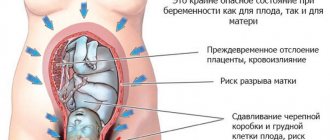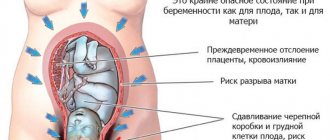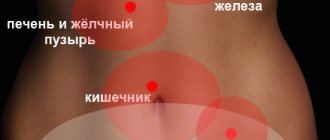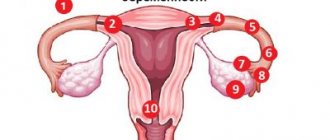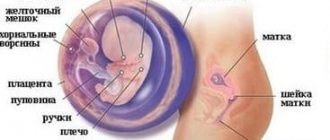Pregnancy for any woman is, first of all, happiness. But do not forget about the great responsibility. After all, now you need to take care not only of yourself, but also of the little lump that is growing inside you. Therefore, we can say that pregnancy is also a great stress, both for the body as a whole and for the nervous system. On the one hand, the expectant mother feels every day that a new life is growing in her, begins to move and even shows her mood.
Sometimes a mother’s happy mood in the last weeks of pregnancy can be overshadowed by the appearance of pain in the lower abdomen, when the stomach pulls and hurts, like during menstruation. A symptom such as pain in the lower abdomen, as during menstruation at 38 weeks of pregnancy, appears very often and in most cases is considered normal. At 38 weeks of pregnancy, a woman, in addition to pain in the lower abdomen, as during menstruation, may experience vaginal discharge. Such discharge is considered normal, but there are a number of discharges that may be a symptom of a certain disease.
- What should a woman do if her stomach feels tight at 38 weeks of pregnancy?
- What to do to relieve stomach pain?
Abdominal pain at 37-38 weeks - what is it?
At 37-38 weeks, the pregnancy is considered full-term. The body begins to prepare for childbirth. Such changes are almost always accompanied by pain.
In addition, pregnancy leaves its mark on the general condition of the internal organs and systems of the body. Pain in the abdominal area can have many causes.
They are usually associated with natural processes. However, sometimes pain can be caused by more serious reasons.
The nature of the sensations, their intensity and localization are very important in this case.
Psychological factor
A large percentage of expectant mothers at the 37th week of their pregnancy experience abdominal pain also because they are psychologically ready for childbirth and are worried. Emotional stress, fear, and anticipation of pain can further provoke them.
In order not to experience additional cramps and abdominal pain at 37 weeks of pregnancy, it is advisable for a woman to remain calm as much as possible and prepare for the birth of a baby as something completely natural, inevitable and desirable, which will bring relief to both her and the future inhabitant of this planet.
A large percentage of expectant mothers at the 37th week of their pregnancy experience abdominal pain also because they are psychologically ready for childbirth and are worried. Emotional stress, fear, and anticipation of pain can further provoke them.
Pain in the lower abdomen
In late pregnancy, the body actively prepares for labor. The uterus begins to tone up and then relax again. The organ will perform similar manipulations during childbirth.
At such moments, the stomach becomes as if it were made of stone. Pain in the lower abdomen may also appear. This is how training contractions manifest themselves. It is quite easy to distinguish them from the real ones. They do not intensify, the interval between them does not shorten.
no-spa will help relieve pain . If the frequency and intensity increase, you should immediately go to the hospital.
Features of pregnancy at 37 weeks
You are 37 weeks pregnant and your lower abdomen hurts; these are normal and safe symptoms, especially if a woman is undergoing her first pregnancy.
During this period the uterus reaches its maximum size. Its weight is about 1 kg. Pain in the legs and back may appear, pressure on the bladder becomes even greater, and the stomach becomes hard a couple of times a day, which can lead to the formation of nagging pain in the lower abdomen at 37 weeks of pregnancy. Quite a few women at 37 weeks experience abdominal pain in the lower abdomen during pregnancy; most women experience only mild discomfort or mild abdominal pain during this period.
From the 37th week, a relatively difficult period in the life of every mother begins. Very often, the expectant mother is haunted by a feeling of helplessness. She is clumsy and suffers from various forms of ailment. And, of course, he is very worried about the baby. Constant worries can also contribute to the appearance of nagging pain in the lower abdomen, or rather intensify the appearance of such symptoms. During this period, pregnant women need to be given maximum attention and care. Particular attention should be paid to your diet - after all, this is the key to the health of mother and baby. The diet should be varied, but you should not overeat. Overeating can cause you to feel a heaviness in your stomach, which can affect your quality of sleep. Overeating can contribute to symptoms such as abdominal pain, bloating and discomfort. Drink more kefir or yogurt, eat cottage cheese, sour cream and cheese, as well as iron-containing foods.
Pain like menstruation
Many women complain that at about 38 weeks their stomach feels like they are on their period. This phenomenon is quite natural and accompanies preparation for childbirth. Thus, the cervix comes into the shape necessary for childbirth. The closer the moment of delivery, the shorter and thicker it becomes.
This is what causes pain. They will be monitored until delivery. Also, a similar process may be accompanied by the passage of a mucus plug, which is a bloody brown clot.
Why does my lower abdomen hurt at 37 weeks?
Many women experience rare abdominal pain in the lower abdomen at 37 weeks of pregnancy. Basically, such pain is a fairly normal and completely safe symptom during pregnancy. 37th week of pregnancy - lower abdomen hurts. If this is your first pregnancy, then you will observe significant changes in your stomach.
What is especially noticeable is that the tummy is drooping. For all women, the tummy drops at different times - for some 2 weeks before the birth itself, for others a few days before the birth, and for some women the tummy drops a few hours before giving birth. At 37 weeks of pregnancy, women often notice that their stomach “turns to stone” and pain appears: for some it is sharp, for others it is aching.
Pain in the back and pelvic bones
In the last weeks of pregnancy, a woman may also experience pain in the back area. This is usually due to increased stress on the muscles.
In order to maintain balance with a shifted center of gravity, the muscular corset has to be strained quite a bit.
All this leads to pain. They are especially pronounced if the back muscles were not sufficiently developed before pregnancy. Using a prenatal bandage will help relieve tension .
In addition, the closer the birth is, the more efforts the body makes to ensure that the pelvic bones become as soft as possible. All this also causes pain in the pelvic area. The closer the birth is, the more the pelvic bones will diverge.
Fetus at 38 weeks of gestation: movements, weight and size
Although childbirth can occur on any day of this week, until it occurs, the pregnancy continues. How is your baby doing?
In male children, by this time the boy's testicles have already descended into the scrotum, but if this has not happened by the time of birth, there may be difficulties in the future. So the doctor should definitely check this “nuance” in the baby.
The original stool meconium is already formed by the 38th week of pregnancy. The small intestine will push it out after birth, but it may hurry up: then the black-green mass goes directly into the amniotic fluid, the baby can swallow it, and the baby’s body in this case is also covered with greenish mucus.
However, now the baby has already become very beautiful! The facial features have been sharpened, the skin has acquired a pleasant pinkish tint, smoothed out, the original fluff and grease have almost disappeared, and hair has probably grown on the head. You can find information about the eye color of a newborn: most of them are born with light eyes, but very often the iris later darkens. If the baby has dark eyes, then most likely they will no longer turn blue. However, from personal experience I say: everything is possible. And your beauty’s dark brown eyes may then unexpectedly become completely light. So don't set yourself up for anything in particular.
You obviously noticed that the baby has become less active - for good reason. There is very little space left, but it continues to grow! At week 38, the weight of the fetus is more than 3 kg, and the height exceeds 50 cm. Naturally, these are average data, and you need to focus more on the “dimensions” of mom and dad at birth.
Listen to the movements. Firstly, these are the last moments of enjoying this sensation. Secondly, if the child does not show any signs, you need to inform the doctor.
In general, by the 38th week of pregnancy, although the baby is not so active, its movements are detected by the mother very well. In half a day, if everything is fine with the baby and he does not experience any difficulties, the baby will make itself known about 10-12 times. If the baby kicks much more often, or, on the contrary, calms down, consult a doctor immediately. Such symptoms almost always indicate intrauterine suffering in the child, and it is quite possible that specialized medical intervention may be needed to correct the situation.
Future mom
Perhaps you are worried about upcoming contractions: how to recognize them so as not to mistake them for false ones. Be calm in this sense: you are unlikely to “sleep through” childbirth. Real contractions are more painful and noticeable; they are repeated periodically, increasing in frequency and intensity.
Lower back pain
Lower back pain has almost the same causes as the pain in the back and pelvic bones described above. During childbirth, it is the lumbar spine that will have to show the greatest activity.
In this regard, in the last stages the body begins to actively prepare it, softening the joints and ligaments.
The situation is aggravated if the expectant mother had problems with joints and vertebrae before pregnancy. Under the influence of ongoing restructuring, the appearance of pain may be associated with exacerbation of chronic diseases of the spine or joints.
Therapy methods
Prenatal bandage corset
If, during a comprehensive examination, it is determined that the cause of abdominal pain is uterine contractions, most likely, the doctor will not prescribe any drug treatment. At week 37, this is an absolutely natural process that may be a harbinger of impending birth.
If the baby is born at this time, it is considered full term. The baby is already able to breathe on his own, latch on and digest food. The first stool, meconium, has already formed in his intestines. The expectant mother should have no reason to worry.
For particularly intense pain caused by uterine contractions, the doctor may prescribe antispasmodics or painkillers based on paracetamol or ibuprofen. The active substance of these drugs, penetrating the placental barrier, does not have a negative effect on the child’s body.
To relieve pain, a woman can wear a prenatal bandage. Such a device allows you to evenly distribute the load on all joints and ligaments, supporting the enlarged stomach and abdominal muscles.
If any pathology has caused discomfort in the lower abdomen, the woman will be referred to a specialized specialist for further treatment.
In some cases, with abdominal pain, a pregnant woman may be hospitalized in a hospital. There is no point in abandoning such a measure. In case of any complications, only timely qualified assistance from medical staff will help preserve the life and health of the mother and child.
Abdominal and back pain
In this case, it is important to establish the pain in the back and abdomen is interconnected
The relationship between the phenomena will be indicated by the girdling nature of the pain. It will originate in the abdomen and gradually move to the back.
In this case, we can talk about training bouts. They are usually also accompanied by a feeling of hardening of the uterus. However, if the pain becomes more noticeable over time, and the time interval between them decreases, then you need to go to the hospital. We are talking about real fights.
Harbingers of childbirth
At 37 weeks, a woman may already begin labor. This is especially true for expectant mothers who are not giving birth for the first time. The following signs indicate impending birth:
- Abdominal prolapse. In late pregnancy, just before giving birth, a woman's stomach drops. Outwardly, this is not very noticeable, but the expectant mother may feel significant relief. The load on the chest is reduced, and it becomes easier for the woman to breathe. The lower the fetus goes, the more the perineum will hurt. The pain syndrome often spreads to the lower extremities.
- Exit of the mucus plug. The plug begins to form at the very beginning of pregnancy and closes the entrance to the uterus to protect the fetus from possible infection. The mucus plug may come out several weeks before or just before giving birth. It looks like a thick viscous discharge, similar to jelly.
- Discharge of water. It is simply impossible to confuse this phenomenon with other processes. Leakage of amniotic fluid may occur during or before contractions begin. However, the breaking of water does not always indicate the onset of labor, so you should not wait for contractions. If a woman notices that her water has broken, she must go to the maternity hospital or call an ambulance.
- Decreased appetite and weight loss. A few days before giving birth, most expectant mothers indicate a decrease in appetite. Sometimes a woman may refuse food for 3-4 days. This leads to the fact that a pregnant woman can lose up to 2 kg in weight.
- Colostrum release. The appearance of drops of milky fluid on underwear or clothing indicates that labor is approaching.
- Pain in the back and lower back. Nagging pain localized in the lower abdomen can spread to the lower back. Painful sensations reminiscent of discomfort before or during menstruation are most often a symptom that labor will soon begin.
- Contractions. This is the most obvious and accurate sign of the birth of a baby. Real contractions, unlike training ones, cannot be weakened by changing body position or contrast shower. They are characterized by severe pain, and the interval between them is constantly decreasing.
As another symptom indicating that labor is approaching, many pregnant women report an increase in energy. All the fatigue that has accumulated over the past months disappears. The woman feels a surge of strength and energy. Her mood improves and she has a desire to do everyday activities.
Pain in the upper abdomen
In this case, it is necessary to take into account the nature of the pain. The occurrence of sharp pain that suddenly appears and goes away can also indicate poor muscle development. This pain is usually observed when walking or other movements.
If the pain is moderate, it is usually associated with deformation of the internal organs. Due to the constant increase in its size, the uterus begins to displace the nearby liver and gall bladder.
All this causes pain. They are usually also accompanied by nausea, heartburn and a feeling of bitterness in the mouth. In addition, pain can be caused by active movements of the baby.
However, pain may be due to some pathological reasons:
- Pancreatitis . This disease also causes pain in the pancreas area. However, the unpleasant sensations are associated not with the deformation of the organ, but with its inflammation.
- Gastritis . During pregnancy, a woman may experience aggravation of many chronic diseases associated with the gastrointestinal tract. They are the ones that cause pain in the upper abdomen.
- Pyelonephritis . Pain due to pyelonephritis can also radiate to the abdomen and lower back. As a rule, it is acute and accompanied by an increase in temperature.
Pain in the pubic bone area
The pubic bone is one of the three main bones that make up the pelvis. Together with the other pelvic bones, it experiences the effect of the hormone relaxin. It prepares ligaments and cartilage for childbirth, softening them.
It is this process that causes pain. However, in some cases, severe pain may indicate symphysitis .
With this disease, there is a divergence of the pubic bones. The disease can be caused by both disruptions in hormonal changes and problems with the musculoskeletal system that existed before pregnancy. A reliable diagnosis can only be made by performing an appropriate ultrasound.
Pain between legs
and muscles must be prepared to the same extent . Sometimes there are situations when the bones are already starting to separate, but the ligaments do not have time to stretch.
This causes pain between the legs. The more the stomach goes down and puts pressure on the pelvic bones, the more intense the sensations will be.
However, sometimes such pain can be pathological and indicate pregnancy complications. In addition, such sensations may indicate the beginning of labor.
Pain in the tailbone
In most cases, pain in the tailbone area is associated with the body’s preparation for childbirth. Because the tip of this organ is bent inward, there is a risk of injury to the baby as it passes through the pelvis.
In this regard, the body tries to make the tailbone as mobile as possible so that during childbirth it can move a little. For this, as is the case with all pelvic bones, the cartilage and ligaments begin to soften.
However, pain in the tailbone can be caused by any disease or inflammatory processes in the pelvic area, as well as hemorrhoids. You must tell your doctor about all your sensations in order to make a correct diagnosis.
Pain in the abdomen, lower back and pelvis can occur at any stage of pregnancy. In each trimester they have their own reasons. Pain can be caused by both natural processes and quite dangerous phenomena.
Only a doctor can reliably understand the reasons for the appearance of sensations, so you need to report all your sensations to him in a timely manner.
The main signs of premature birth
1 Abbreviations. Severe tension in the abdomen occurs, such contractions may recur after 10 minutes or more often;
2 Pain and pressure in the pelvic area, the baby seems to be pressing on the cervix;
3 Painful sensations that are very similar in type to pain during menstruation.
Other signs of premature birth include:
1 Aching pain occurs in the lower back;
2 Fluid begins to come out of the vagina, and bleeding may begin.
In addition, pain in the lower abdomen at 37 weeks of pregnancy can be caused by circular ligament pain, placental rupture and preeclampsia. If, against the background of spasms, a woman experiences severe bleeding or heavy discharge, she should urgently consult a doctor; this may indicate a serious problem. Many women experience pain in the lower abdomen of moderate intensity throughout the entire period of bearing a baby. Most often, there is nothing serious about this; their cause may lie in the formation of gases, constipation and stretching of the uterus.
Over time, pain in the circular ligament may intensify on one side of the abdomen; in rare cases, pain occurs on both sides. Most often, the intensity of pain manifests itself in the pelvic area on the right side. Fortunately, you can quickly cope with painful sensations on your own; to do this, you just need to relax or change your body position. Such pains can go away if you lie on the side opposite from the pain.
Quite often, women experience pain in the lower abdomen precisely at 37 weeks of pregnancy. Most often, the cause of this phenomenon is precisely the pain of the circular ligament, and the pain of such a circular ligament occurs in most cases as a result of normal, natural changes that occur with every woman during pregnancy. The size of the uterus during pregnancy is equal to an average pear. Thick ligaments, one of which is called the circular ligament, are needed to provide support inside the abdomen of the uterus.
Even minor physical exercises can cause circular ligament pain. Fortunately, not every woman encounters this phenomenon while carrying a baby. Moreover, absolutely all women during this period experience strong changes in the body, this occurs as a result of the production of progesterone and an increase in the child’s uterus.
